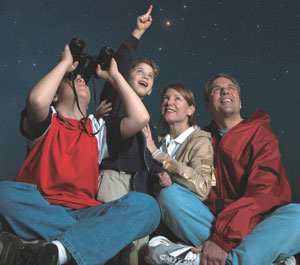
Encourage your home team to explore the planets, stars, and constellations together.
S&T: Craig Michael Utter / Akira Fujii
The best time of the year to introduce family and friends to the night sky will soon be here: summer. Chances are you’ll be outside in the evening anyway, on vacation, camping, or even just having a relaxing barbecue in the yard — so why not treat them to a night under the stars? After all, eyeball astronomy is free! Besides, there’s a lot overhead to see. Even if you’re not blessed with skies dark enough to reveal the Milky Way, summer (and winter) skies offer many bright stars that can serve as jumping-off points to a celestial treasure hunt.
Before you head out the door with everyone in tow, make sure you have everything you need to be comfortable. Lawn chairs that recline are perfect for stargazing, but even a couple of blankets spread out will do. Insect repellent is generally a must on those humid summer nights, but warm clothes are also a good idea — once the Sun sets, the temperature can fall rapidly, and standing still or lying down will cool your body quickly. Finally, everyone gets hungry, so have some munchies handy.
As for stargazing needs, the first consideration is finding dark skies — you’ll always see more if you can get away from light pollution. Even your neighbors’ porch light shining in your eyes will detract significantly from the view overhead. As a demonstration, go outside and look up. How many stars can you see? After about 10 minutes, check again — you should count many more stars. This is due to your eyes adjusting to the dim light levels, also referred to as dark adaptation. Now turn on a light for just a few seconds, and look up one more time. Many stars will have vanished — at least until your eyes again adjust to the darkness.
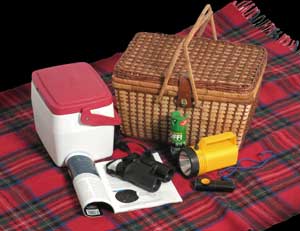
Don't forget a few essentials — star charts and a red flashlight — when you head out for a night under the stars. Bring some light snacks and something to keep you dry when the grass starts to get dewy.
S&T: Craig Michael Utter
You might want to bring star charts to find your way around. You can make your own planisphere or "star wheel," perfect for viewing the sky with your eyes alone, with the plans we've provided. To examine those charts in the dark, you’ll want a red-filtered flashlight. Astronomers use these because red light doesn’t affect your night vision as much as white light does. And I’ve learned that you can never have too many red flashlights — every child in your group will want his or her own!
Binoculars of any size are good to take along too, even if you’re also using a telescope. Not only do they give a nice wide-field view of whatever you might be showing in the telescope, but stargazing with binoculars can be a thoroughly satisfying activity by itself.
Learn Some Constellations
Astronomy can be enjoyed without any extra equipment at all — just a bit of knowledge can make the night sky intriguing. First, you can learn some of the rich lore about the heavens. Any small fact helps, such as that Scorpius is one of the few constellations that actually looks like its namesake. Another tidbit is that the Big Dipper is only a part of a larger constellation, Ursa Major, the Great Bear.
Why not make up a game with the kids, such as “connect the dots” using bright stars? Or let them make up their own constellations! After all, that’s what ancient skywatchers did long ago, and those are the constellations we see today. Your clan can either make up whimsical creatures on the spot or pick out a star pattern to remind them of a loved one, whether distant or departed, that they can revisit night after night.
An easy way to learn the sky is to use the brighter stars and patterns as pointers to other constellations. For instance, the two stars forming the bottom of the Big Dipper’s bowl point to the right toward Polaris, the North Star. (You’ll be surprised how excited people of all ages get when this is first brought to their attention.) Now note the curved line made by the stars in the Dipper’s handle. Follow that curve upward until it reaches a bright, reddish star named Arcturus — you’ll be following the “arc” to Arcturus, whose name derives from Greek words meaning “guard of the bear.”
You can also plays some constellation games with the Star Deck.
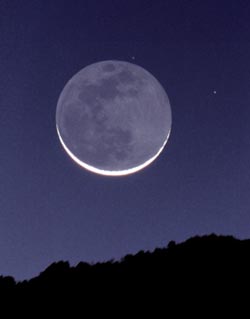
The night sky offers many beautiful and unusual things to see. Here's a striking example of earthshine, a ghostly glow on the Moon's night side caused by sunlight reflected by Earth.
Touring with Binoculars
A good target to begin with your binoculars is the Moon. It offers the best views of any object in our solar system, simply due to its proximity to Earth. Because of this, it’s a natural draw for anyone with even a slight interest in the sky. Without any equipment at all, you and your clan can watch the changing phases from night to night. When the Moon is very “young,” just two or three days after new, have a friendly contest to see who can spot the slender crescent hanging low in the sky after sunset.
As twilight deepens, you’ll often see the dark side of the Moon aglow with sunlight that’s been reflected off Earth’s clouds and oceans — an effect called earthshine. Binoculars or even the simplest telescope can reveal craters, mountain ranges, and lava-filled seas. From one evening to the next, different features will reveal themselves with the slow rising and setting of the Sun across the lunar landscape.
A great group activity is to have each person draw a sketch of the Moon as it looks to him or her through binoculars or a telescope. This is something especially well suited to younger skygazers, and comparing the drawings after everyone has finished should be pretty amusing! But it also helps develop good observing skills too. Note that while binoculars show a normal (magnified) view, most telescopes turn the Moon and sky upside down or flip it as though you’re looking into a mirror.
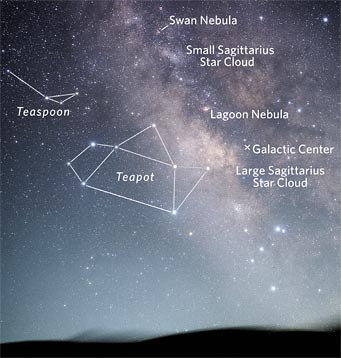
The brightest puff of the summer Milky Way seems to rise like steam from the spout of the Sagittarius Teapot. All of the labeled objects here are good binocular targets under a dark sky. Click image for a larger view.
Alan MacRobert
During summer, you'll have the best area of the sky to browse with binoculars. At that time in the south, the heart of our home galaxy, the Milky Way, awaits you. This dense river of stars is a great place for a celestial hunt with binoculars. Begin low in the south with the constellation Sagittarius and its easy-to-spot Teapot, complete with “steam” rising from its spout. The steam contains the bright Lagoon Nebula, which in 8×50 binoculars shows up as a small cluster of stars with a diffuse glow surrounding it. Above this you should see a second glow, the Trifid Nebula.
Use your binoculars to follow the Milky Way upward, toward the northeast, and you’ll pan across many bright star clouds, dark nebulas (clouds of dust and gas that block the light of the stars behind them), and star clusters. Many of these are charted in the Messier catalog, a list of 109 objects compiled by Charles Messier in the 1700s so he could avoid mistaking them for comets. If you have a star chart that plots the locations of Messier objects, a fun project is to see who can locate the most Messier objects in binoculars in one evening.
Expectations at the Eyepiece
Telescopes can be a great crowd-pleaser, but it’s important to keep everyone’s expectations realistic. This is especially important when young children are present. Apart from the Moon and planets, celestial objects never look like the pictures you see in books and on the Internet. One big reason is that our eyes react instantaneously to light, while photographs represent light accumulated from dim objects over many minutes or even hours. Also our night vision does a poor job of detecting color — nebulas that appear gloriously red or green in photographs look dim and gray by eye. Half the excitement of using a telescope is appreciating that you can even see these objects at all!
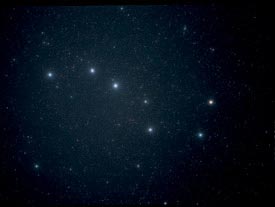
Look for Mizar and Alcor in the bend of the handle of the Big Dipper. Spotting these two stars with the naked eye is a good test of your vision! Click on the image for a close-up view of Mizar (with Alcor), the center star in the handle of the Big Dipper.
One can’t-fail telescopic treat is the star at the bend in the Big Dipper’s handle — because it’s really two stars close together, bright Mizar and slightly fainter Alcor. See if anyone in your group can discern two distinct points of light. Next, pass the binoculars around; you’ll discover that there’s a third star in this group. Finally, show everyone the same thing once again in a telescope with moderate to high magnification — there’s a fourth star! (Mizar has a very close companion.)
Observing with a telescope takes practice — you need to look at the planets or other celestial objects a lot before your eye becomes accustomed to subtle details and contrasts. Seeing Jupiter’s cloud belts or dark features on the surface of Mars requires both a good-quality telescope and a patient eye. Show your family a few pictures of the objects you plan to look at ahead of time. Then explain that although the fainter objects don’t look like much in the telescope at first, the longer you look at them the more you see.
Helping Hands
If you’re just getting your astronomical bearings and uncomfortable serving as a celestial tour guide, there are other ways to have a great night under the stars. Why not plan a visit to the local planetarium? This is a great way — especially if you live in a light-polluted city or town — to get familiar with all that the night sky has to offer.
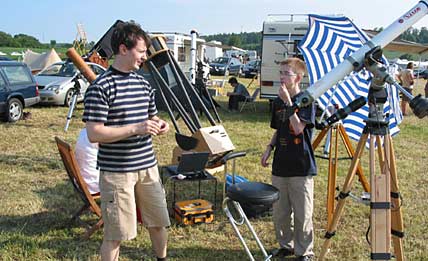
”Star parties” are a great way for beginners to get out under the stars. There you”™ll get to view sparkling celestial sights through a wide variety of telescopes. Hundreds of these family-oriented events are held each year across North America.
Is there a local astronomy club in your area? If so, its members will be more than happy to give you some observing tips or to teach you how to use your telescope. Astronomy clubs usually have weekly or monthly observing sessions, and some host large gatherings that attract hundreds of like-minded astronomers eager to share the sky with anyone. These “star parties” offer entertainment for all members of the family, even if astronomy isn’t their primary interest. To track down a club or event in your area, visit our online directory.
As you can see, the night sky is full of ways to draw your family’s gaze collectively upward — whether you’re lying on your back in a field teaching the constellations or showing off a galaxy 10 million light-years away in your computerized telescope. Just try to find activities that appeal to your group, and feel free to tinker with these projects to suit your abilities. Then who knows? You may be having company at the eyepiece more often.
More Ideas Online
The Internet is full of astronomical activities for students and classroom settings, yet while many of these can be adapted for use at home, the pickings are slimmer for activities designed with families in mind. You can find some great projects at At Home Astronomy and Family Astronomy Activities from the Canadian Astronomical Society.
One oasis of ideas is a program sponsored by the Astronomical Society of the Pacific. “In part we developed Family ASTRO because there was such a dearth of family-oriented material on the Web,” notes project creator Andrew Fraknoi. The ASP offers “Night Sky Adventure,” a set of well-explained activities that can be enjoyed by children of all ages.
When he’s not imaging planets and “faint fuzzies” with his electronic astro-camera, Sean Walker shows his daughter how to find the North Star and lets her take quick peeks at the Moon through his telescope.
 0
0
Comments
You must be logged in to post a comment.